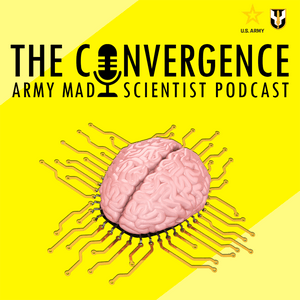The Convergence - The Army's Mad Scientist Podcast

115 episódios

117. From Campus to Command: The William & Mary Wargaming Lab with Luke Miller
11/9/2025 | 24min
[Editor’s Note: Army Mad Scientist and the Georgetown University Wargaming Society co-hosted our Game On! Wargaming & The Operational Environment Conference at Georgetown University, Washington, DC, last November, exploring: Trends in hobbyist wargaming; How wargames can address unconventional and neglected aspects of the Operational Environment; How wargaming can provide experiential learning for Professional Military Education (PME); and How technology is enhancing wargaming. Attended by approximately 150 participants, with an additional 20-odd virtual participants live streaming it remotely, the conference facilitated an open dialogue with wargamers from both inside and outside the military (e.g., professional, commercial, and hobbyist gamers). At that conference, we hosted a Gen Z & Wargaming Round Table for the sizeable contingent of students attending the conference from Georgetown University, the University of Nebraska Omaha, and the College of William & Mary. Today’s episode of The Convergence podcast features Luke Miller, who attended our conference last year, is a wargame designer, and is this academic year’s Director of the William & Mary Wargaming Lab. Army Mad Scientist sat down with Mr. Miller to discuss the role of wargaming and the university’s on-going wargaming projects with the War Department, his thoughts on wargame design and education in the military, and the future of wargaming — Read on!] [If the podcast dashboard is not rendering correctly for you, please click here to listen to the podcast.] Luke Miller is an undergraduate student at the College of William and Mary, studying International Relations and Economics. During the Summer of 2024, he was an e-Intern with the TRADOC G-2, where he researched national security threats to the U.S. and proposed solutions for Army adaptation to emerging challenges. Specifically, Mr. Miller conducted focused research on U.S. Army preparedness for a potential conflict with China over Taiwan. Mr. Miller is also a member of The Alexander Hamilton Society, a Global Scholar with the William & Mary Global Research Institute, and game designer and now Director of the William and Mary Wargaming Lab. In our latest episode of The Convergence podcast, we sat down with Luke Miller to discuss the value of wargaming as part of higher education, designing games for both students and defense partners, and emulating an accurate and realistic red team. The following bullet points highlight key insights from our conversation: The College of William and Mary’s Wargaming Lab, within their Whole of Government Center of Excellence, is known as the first fully undergraduate-led wargaming design initiative in the country. Through support from subject matter experts in the defense and national security fields, the Lab creates wargames and games for national security policy analysis and career professionals. The Wargaming Lab designs wargames from the ground up, including researching content, game mechanics, and Specifically, the team has created various scenario-based micro-games, table-top games, and boardgames, focusing on qualitative results that can support policy analysis for specific customers, such as General Mark Matthews (USAF-Ret.). The beauty of working through this problem set in an academic forum are the differ...

116. Do Androids Dream of Electric War: The Reality of Autonomous Weapons with Dr. Mark Bailey
28/8/2025 | 25min
“I think there’s a moral question that one has to ask in general about whether it’s appropriate for a machine to make a decision as to whether or not a human ought to live or die” [Editor’s Note: As observed in TRADOC Pamphlet 525-92, The Operational Environment 2024-2034: Large-Scale Combat Operations: “The increase in the production, employment, and success of uncrewed systems means the Army can expect to encounter these systems across the breadth and depth of LSCO.” Contemporary conflicts in Ukraine and Middle East have witnessed the burgeoning use of autonomous weapons — empowering lesser states (i.e., Ukraine) and non-state actors (i.e., the Houthi Movement in Yemen) to conduct asymmetric strikes against nations with more robust military capabilities (i.e., Russia and Israel, respectively). These capabilities are transforming warfighting in both the air/land and land/sea littoral, eroding and possibly negating traditional concepts of air and naval superiority. The battlefield successes achieved using these autonomous technologies has led to them being rapidly proliferated around the globe, with Transnational Criminal Organizations (TCO) like the Jalisco New Generation Cartel (CJNG) effectively employing armed Unmanned Aerial Vehicles (UAVs) against both their criminal competitors and the Mexican authorities alike. In the ongoing race to develop more effective (read lethal) combat systems capable of overcoming kinetic and electromagnetic countermeasures, some nations are integrating Artificial Intelligence (AI) and Machine Vision (MV) with Lethal Autonomous Weapons Systems (LAWS) — in essence removing human operators from within or on the OODA loop. U.S. policy on LAWS is documented in DoD Directive 3000.09, Autonomy in Weapon Systems, which includes the following statement: “Autonomous and semi-autonomous weapon systems will be designed to allow commanders and operators to exercise appropriate levels of human judgment over the use of force.” Per the U.S. Congress’s Defense Primer: U.S. Policy on Lethal Autonomous Weapon Systems: “U.S. policy does not prohibit the development or employment of LAWS. Although the United States is not known to currently have LAWS in its inventory, some senior military and defense leaders have stated that the United States may be compelled to develop LAWS if U.S. competitors choose to do so. At the same time, a growing number of states and nongovernmental organizations are appealing to the international community for regulation of or a ban on LAWS due to ethical concerns.” Today’s episode of The Convergence podcast features Dr. Mark Bailey, Department Chair, Cyber Intelligence and Data Science, National Intelligence University, exploring the tension that exists between the rapid convergence of AI and battlefield autonomy and our national values requiring transparency and oversight in our use of lethal force. Wit...

115. 15 Layers Deep: Supporting Soldiers with Geospatial Intelligence
14/8/2025 | 44min
[Editor’s Note: As observed in TRADOC Pamphlet 525-92, The Operational Environment 2024-2034: Large-Scale Combat Operations: “LSCO will be marked by the democratization and proliferation of advanced technologies and hyperconnected global communications, creating an increasingly transparent battlefield that makes it difficult to hide from the enemy.” Today’s The Convergence podcast features Jason Feser from the U.S. Army Geospatial Center exploring just how transparent the contemporary battlefield has become. With the convergence of sensing technologies, democratized space, and Artificial Intelligence (AI) / Machine Learning (ML), this capability is empowering our Soldiers with a granular situational awareness of the Operational Environment, down to an eight-digit (plus!) grid reference. Modern LSCO is now a competition between the hiders and the finders — if a target can be seen, it can be killed! Our adversaries have similar sensing capabilities — but in the contemporary Operational Environment, warfare favors those who can innovate tactically. The tactical advantage offered by this granular level of battlefield transparency is lost if it can’t be shared with and used by Warfighters at the bleeding edge of the fight — Read on!] CW4 Jason Feser (USA-Ret.) currently serves as Branch Chief for Data Generation and Production, Warfighter Support Division, within the U.S. Army Geospatial Center (AGC). In this role, Mr. Feser oversees a staff of civilians and contractors that enable geospatial data collection, processing, and dissemination to the U.S. Army’s generating and operating force. Mr. Feser is responsible for three critical product lines to meet the Army’s requirements for digital mapping and geospatial analysis for customers at all echelons — the AGC’s Engineer Route Study, Regional Terrain Planner, and Urban Tactical Planner. This includes updating the production pipelines, managing Army Geospatial Engineer Teams, and leveraging capabilities and tools found within the broader U.S. Army Corps of Engineer Research Development Centers and Joint Communities. Prior to joining the AGC as a civilian, Mr. Feser spent 27 years in the Army as a Geospatial Engineer and Geospatial Engineering Technician, before retiring in 2019. Mr. Feser spent over fifteen years at the tactical level before moving on to Joint and Strategic assignments. His assignments included serving in multiple Engineer Brigade Headquarters in Heavy Divisions; a Branch Chief in the IDG at JAC Molesworth; NATO Special Operations Intel Branch at the NATO Intel Fusion Center; Senior Geospatial Officer and Commander at the 512th Geospatial Planning Cell; and Military Advisor to the AGC Director. Mr. Feser’s career included deployments to Bosnia, Kosovo, Iraq, and Jordan. He holds an Undergraduate degree in Applied Science, with an Emphasis in Geospatial Information Systems, and he has completed professional military technical training throughout his career. In our latest episode of The Convergence podcast, Army Mad Scientist sat down with Mr. Feser to explore the AGC, the role advanced technologies play in battlefield transparency, and our adversaries’ capabilities to observe and sense the Operational Environment. The following bullet points highlight key insights from our conversation. Geospatial engineers are embedded within U.S. Army formations to conduct Geospatial Intelligence (GEOINT) analysis on elements of the Operational Environment that will impact operations, including cultural, institutional, and physical aspects that may challenge our forces across multiple domains. The Army Geospatial Center (AGC) supports these ge...

114. Data to Dominance: AI & Gaming to Create Decision Advantage with Jon Pan
31/7/2025 | 46min
“Agentic warfare is here, whether we welcome it or not. The era of military planners manually gathering limited data and compiling static crisis response options on briefing slides is over. In the next few years, the defense community will see the emergence of AI agents representing military planners, logisticians, intelligence officers, and operators that harness centuries of stored experience in real-time digital collaboration, generating uniquely effective crisis solutions for human decision-makers in seconds…. First-mover advantage in leveraging this capability will not merely ensure battlefield dominance — it will be overwhelmingly decisive at every level of warfare. It could herald the dawn of a new defense paradigm, supplanting the outdated defense-industrial complex with an agile, AI-driven agentic base. The stakes could not be higher….” — Agentic Warfare Is Here. Will America Be the First Mover? War on the Rocks, 23 April 2025. [Editor’s Note: The article cited above predicts that agentic capabilities — i.e., those Artificial Intelligence (AI) systems that can operate independently, making decisions and executing actions without constant human supervision — when “employed by [our] adversaries… will dramatically outperform traditional Western paradigms of 24- to 72-hour decision cycles and wartime initiative.” While not specifically using the term “agentic warfare,” today’s The Convergence podcast features Jonathan Pan describing how this capability could accelerate the Army’s Military Decision Making Process (MDMP), enabling us to achieve decision advantage and fight at machine speed — Enjoy!] Jonathan Pan is the co-founder and CEO of Exia Labs, a defense technology startup. Exia’s products include Blue, an Army brigade decision support tool, and Recon, an Intelligence Preparation of the Operational Environment Artificial Intelligence (AI) agent. Prior to founding Exia, Mr. Pan was Senior Director of Product Management at the innovation unit of Walmart, where he led AI projects focused on shopping search and immersive shopping. He also led product and content teams at Amazon, Meta, and Riot Games, and served as an advisor for the SXSW Conference Internet and Gaming tracks between 2017 – 2022. Prior to joining industry, Mr. Pan served in the U.S. Army, beginning his career as a platoon leader in the 2nd Infantry Division in the Republic of Korea. He deployed to Afghanistan as part of 5th Stryker Brigade Combat Team, 2nd Infantry Division. After leaving active duty, he briefly served in the New York Army National Guard’s 1st Battalion, 69th Infantry Regiment. His awards and decorations include the Bronze Star Medal, the Combat Infantryman Badge, the Expert Infantryman Badge, and the Parachutist Badge. He continues his service in the Army as a civilian Army Reserve Ambassador for the state of Washington, where he focuses on increasing awareness of the United States Army Reserve among local communities, civic leaders, and state legislators, with the goal of enhancing support for the Army Reserve, its personnel, and their families. Mr. Pan is also a Visiting Fellow at the Hoover Institution, Stanford University, where he conducts research on the intersection of artificial intelligence and wargames. He has a Master of Business Administration from Ne...

113. Beyond Venture Capital: How the Government is Investing in Innovation
18/6/2025 | 37min
[Editor’s Note: Regular readers of the Mad Scientist Laboratory understand the transformative potential of Large Language Models (LLMs) and Artificial Intelligence (AI) have on the character of warfare — for a comprehensive list of previously published blog posts and podcasts exploring the potential application of these technologies across the Operational Environment, scroll to the bottom of this post and explore the content associated with each of the associated links. Today’s The Convergence podcast features two senior leaders from In-Q-Tel (IQT) discussing how their not-for-profit company is accelerating the introduction of groundbreaking technologies to facilitate innovation within the Department of Defense (DoD) and the Intelligence Community (IC), enhancing the national security and prosperity of the United States and its Allies — Enjoy!] Murali Kannan leads Enterprise Technologies at In-Q-Tel (IQT) as Vice President and Practice Lead, where he directs investment strategy for enterprise data infrastructure, generative AI applications, and AI-enabled vertical solutions. Working closely with venture partners and government stakeholders, he identifies and invests in innovative startups addressing critical national security challenges for the U.S. and allied intelligence and national security communities. Prior to joining IQT, Murali built his expertise at Accenture, Mythics, and GDIT, where he spearheaded teams delivering transformative data analytics initiatives across commercial and government sectors. His educational background combines business acumen with technical expertise, including an MBA from MIT Sloan, a Master’s from Northeastern, specialized certifications from Georgetown and Columbia, and leadership training from Harvard Business School. Coley Lewis’ career at IQT spans over 10 years and he has served in various capacities over his tenure. He currently serves as Vice President of Growth Partnerships, where he leads a team responsible for the identification, development, and execution of new partnerships within the national security community. Coley sets the growth strategy for IQT and works across IQT teams to successfully onboard new partners and maximize impact to mission. Prior to joining IQT, Coley was the Senior Policy & Management Analyst for the United States District Court for the Eastern District of Missouri (USDC-MOED), where he led data analytics for the Clerk’s Office, particularly the collection, analysis, and reporting of judicial business. Lewis holds a bachelor’s degree in history from Truman State University and a master’s degree in public administration from Saint Louis University. In our latest episode of The Convergence podcast, Army Mad Scientist sits down with Messrs. Kannan and Lewis to discuss IQT’s mission and history, explore how it is helping the Government foster innovation, and obtain their insights regarding the boom of LLMs permeating the Federal Government. The following bullet points highlight key insights from our conversation. In-Q-Tel fills a critical gap by investing in start-up companies that develop cutting-edge AI technology tailored for public-sector use cases. Public-private partnerships are critical to the DoD’s ability to fully utilize emerging technologies. AI is improving at an incredible rate. The time between research and implementation of new AI products...
Mais podcasts de Ciência política
Podcasts em tendência em Ciência política
Sobre The Convergence - The Army's Mad Scientist Podcast
Ouça The Convergence - The Army's Mad Scientist Podcast, PreAccident Investigation Podcast e muitos outros podcasts de todo o mundo com o aplicativo o radio.net

Obtenha o aplicativo gratuito radio.net
- Guardar rádios e podcasts favoritos
- Transmissão via Wi-Fi ou Bluetooth
- Carplay & Android Audo compatìvel
- E ainda mais funções
Obtenha o aplicativo gratuito radio.net
- Guardar rádios e podcasts favoritos
- Transmissão via Wi-Fi ou Bluetooth
- Carplay & Android Audo compatìvel
- E ainda mais funções


The Convergence - The Army's Mad Scientist Podcast
baixe o aplicativo,
ouça.





































